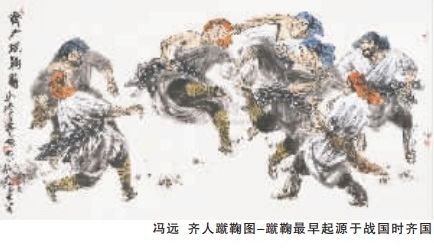China's connection with football in ancient times
- By Chen Boyuan
 0 Comment(s)
0 Comment(s) Print
Print E-mail China.org.cn, July 10, 2014
E-mail China.org.cn, July 10, 2014
 |
|
Though China failed to qualify for the World Cup in Brazil, it does have a historical connection with the game, which, according to FIFA, originated in China. [File Photo] |
The Chinese game that developed into modern football was called Cu Ju, literally meaning kickball. It was created in the Han Dynasty (202 BC-220 AD). Emperor Liu Bang (256-195 BC), a fan himself, had a football field set up in the royal palace.
In Cu Ju, players started a game from the middle line, put the ball into play from side lines and took penalty shots from baselines. On each side of the field there were six goals, or holes more specifically, with six goalkeepers guarding them. In addition to the keepers, six players from each team competed.
Following the emperor's demands, players should not purposefully commit fouls and had to respect referees, who had to be fair. A local panel would review any disputes that happened during the game and had the authority to issue a final ruling.
In the Tang Dynasty (618–907 AD), the game was modified to have one goal with a net on each side. Players tried to send the ball into the opponent's net, which started to make the game resemble modern football.
The goal had a frame of about 31 square centimeters, meaning players had to be precise in order to score. It was a feat that would challenge modern superstar players like Diego Maradona and David Beckham.
Emperor Zhao Ji (1082-1135) was a diehard football fan. Apart from the ruling, his roles included what's comparable to the chairman of the national football association and head of the fan club. He not only competed in the sport but also promoted the game with his authoritative powers.
During the Tang and Song dynasties, football started to become a leisure activity that didn't necessarily involve competitions. People practiced skills like kick-ups wherever they could.
Football players, who were on the royal staff, enjoyed high social status in the Song Dynasty (960-1279). They wore team jerseys during major ceremonies that included canonizing princes, promoting ministers and receiving international guests.
Qiyunshe( Cloud-high Club) was the most prominent football club in the Song Dynasty. Their influence could be compared to Real Madrid in La Liga today. Qiyunshe, based in the capital city of Kaifeng, even expanded to have teams in other cities.
Players in Qiyunshe followed a strict code of conduct. They were prohibited from participating in the "Ten Commandments" that included spreading rumors, gambling, provocations and alcoholism. Members in the club were required to respect coaches and fellow players, practice honesty, wear decent clothes and honor their social status.
Football in China declined during the Ming Dynasty (1368-1644), when aristocrats and government officials practiced the sport instead of working. Even prostitutes practiced football skills as a way to attract men which further reduced the sport's reputation as a royal and respected game.
Rulers in the Qing Dynasty completely banned football. Not long after, modern football was introduced to China and totally replaced the ancient game of Cu Ju.






Go to Forum >>0 Comment(s)